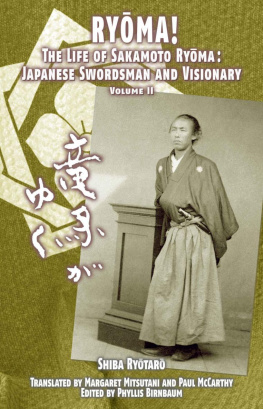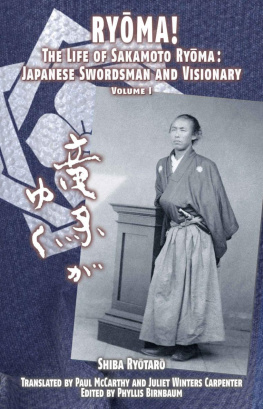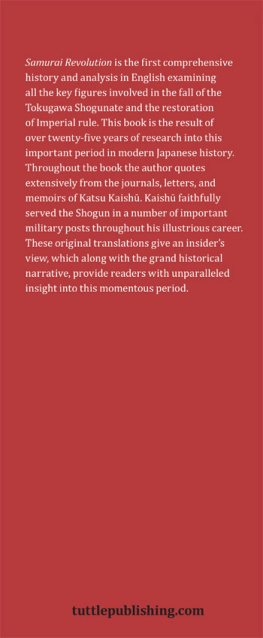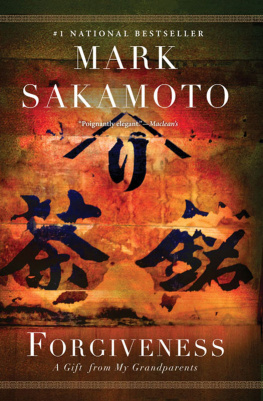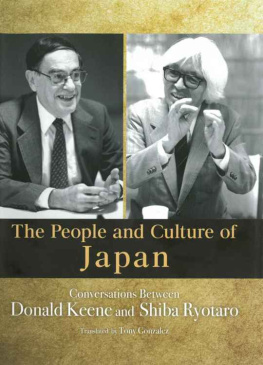Table of Contents
RYMA!
The Life of Sakamoto Ryma:
Japanese Swordsman and Visionary
Volume II
Shiba Rytar

Translated by
Margaret Mitsutani and Paul McCarthy
Edited by Phyllis Birnbaum
Originally published as Ryma ga yuku by Bungei Shunjsha, Tokyo, Japan
Copyright 1963 Shiba Rytar.
Copyright 2018 Uemura Yko & Shiba Rytar Memorial Foundation.
English Translation:
Copyright 2018 Takahashi Akira.
All Rights Reserved
No part of this book may be reproduced, or stored in a retrieval system, or transmitted in any form or by any means, electronic, mechanical, photocopying, recording, or otherwise, without express written permission of the publisher.
Cover photo: Sakamoto Ryma Memorial Museum, Kchi, Japan
Calligraphy: Shiba Rytar
Cover design: Ralph Guggenheim, Alligator Planet LLC
Sakamoto Rymas family crest, the Chinese bellflower, appears on the cover and elsewhere in the text
PRINCIPAL CHARACTERS
Chiba Jtar (1824-1885): oldest son of Chiba Sadakichi and expert swordsman of the Hokushin Itt School. He came to know Ryma at the Oke-ch Chiba Dojo in Edo (present-day Tokyo), which was run by his father.
Chiba Sadakichi (1797-1879): head of the Oke-ch Chiba Dojo in Edo, where Ryma was a student. A follower of the Hokushin Itt School of kendo, he came from a family of noted swordsmen. His brother Shsaku headed the Otamagaike Chiba Dojo in Edo.
Chiba Sanako (1838-1896): Chiba Sadakichis daughter and an accomplished swordswoman of the Hokushin Itt School. She came to know Ryma at the Oke-ch Chiba Dojo in Edo, which was run by her father.
Chsokabe: samurai clan from Tosa Province in present-day Kchi Prefecture; achieved its greatest power under Chsokabe Motochika (1539-1599), who gained control of Tosa and the rest of Shikoku. The clan was defeated by Tokugawa Ieyasu during the battle of Sekigahara in 1600. For their services to Ieyasu at that battle, the Yamauchi clan became the rulers of Tosa, while the former retainers of the Chsokabe were driven out of office and became low-ranking gshi. The Sakamoto family were descendants of those Chsokabe retainers
Fukuoka Kunai (1827-1906): house elder of the Tosa domain; older brother of Tazu-sama, one of Rymas love interests. Although the Sakamoto family was rich, they were only lowly gshi, under the patronage and control of House Elder Fukuokas family.
Gompei (1814-1871): Rymas older brother.
Happei (1797-1856): Rymas father.
Ii Naosuke (1815-1860): from a prominent family that provided great elders (akin to premiers) for the shogunate in times of crisis. He signed commercial treaties with the West and tried to minimize the power of the imperial loyalist faction. Author of the severe Ansei Purge, he was assassinated at the Sakurada Gate of the shoguns Edo Castle by members of the loyalist faction.
Itagaki (Inui) Taisuke (1837-1919): upper samurai in Tosa and disciple of Yoshida Ty, the assassinated reformer. He reorganized the Tosa military and led it against shogunate troops in the Boshin War. Later, during the Meiji era, he advocated greater equality of the classes and a more representative government.
Iwasaki Yatar (1834-1885): low-ranking jige rnin of Tosa who, despite his humble beginnings, worked under the important domain official Yoshida Ty. He held a series of official positions in Tosa, and after the Meiji Restoration, he founded the vast Mitsubishi empire.
Katsu Kaish (Rintar) (1823-1899): acting magistrate for warships and mentor of Sakamoto Ryma; captain of the Kanrin Maru, the first modern Japanese ship to cross the Pacific.
Katsura Kogor (Kido Takayoshi) (1833-1877): loyalist leader from Chsh largely responsible for the anti-shogunate alliance of Chsh and Satsuma. He was a friend of Sakamoto Ryma of Tosa and occupied important government posts after the Restoration under his newly adopted name Kido Takayoshi.
Kmei, Emperor (1831-1867): emperor of Japan during the time of this novel, 1846-1867.
Matsudaira Shungaku (Yoshinaga) (1828-1890): lord of the Fukui domain, Echizen Province; known for his intelligence, he was one of the four wise lords of the late Tokugawa period, together with Date Munenari of the Uwajima domain, Yamauchi Yd of Tosa, and Shimazu Nariakira of Satsuma.
Mri Takachika (1819-1871): thirteenth and last daimyo of Chsh who was a fierce opponent of the shogunate and a major cause of their downfall.
Mutsu Munemitsu (Ynosuke) (1844-1897): samurai from the Wakayama domain who aided Sakamoto Ryma in managing Katsus naval school, in the formation of the Kaientai, and in anti-shogunate activities; foreign minister at the time of the First Sino-Japanese War of 1894-1895, he is best known for his leading role in the revision of the unequal treaties the Tokugawa shogunate had signed with the Western powers.
Nasu Shingo (1829-1863): Tosa gshi and member of Takechi Hampeitas Loyalist Party. Along with Yasuoka Kasuke and ishi Danz, he assassinated Yoshida Ty in 1862.
kubo Ichi (Tadahiro): (1818-1888): adviser to Shogun Yoshinobu and a progressive, high-ranking shogunate official, who, together with Katsu Kaish, supported Sakamoto Ryma.
kubo Toshimichi (Ichiz) (1830-1878): Satsuma samurai and one of the leaders of the anti-shogunate movement, he went on to play a major role in the establishment of the Meiji government.
Otome ( 1832 - 1879 ): Rymas older sister, who was a great influence on his life.
Saig Takamori (Kichinosuke) (1828-1877): Satsuma samurai and powerful personality in the anti-shogunate movement, he led pro-imperial troops in the final battle against the shogunate army and was behind the shogunates surrender of Edo, which led to the establishment of the Meiji government.
Sakamoto Ryma (1835-1867): master swordsman and Tosa loyalist who was a friend of the Loyalist Partys Takechi Hampeita. Eventually, he became associated with Katsu Kaish, the shogunates naval magistrate, and helped him with his naval school in Kobe; formed the Kaientai (Naval Auxiliary Force) following the dissolution of the naval school and helped to arrange the alliance between the Chsh and Satsuma domains, which was crucial to the overthrow of the shogunate.
Sanj Sanetomi (1837-1891): court noble who vigorously supported the emperor in his bid to regain authority over the shogunate and to expel the foreigners from Japan; after the expulsion of imperial loyalists in the 1863 coup, he fled to Chsh, but later he served in the Meiji government.
Shimazu Hisamitsu (1817-1887): regent for his son Tadayoshi, who succeeded Shimazu Nariakira as daimyo of Satsuma, 1859-1868.
Shimazu Nariakira (1809-1858): daimyo of Satsuma 1851-1858 and one of the four wise lords of the late Tokugawa period, together with Date Munenari of the Uwajima domain, Yamauchi Yd of Tosa, and Matsudaira Shungaku of Fukui.
Takechi Hampeita (Zuizan) (1829-1865): Tosa shirofuda who became a master of swordsmanship and a leader of the radical imperial loyalists. A friend of Sakamoto Ryma, he organized the Tosa Loyalist Party. He was implicated in the assassination of the moderate Tosa reformer Yoshida Ty and eventually forced to perform seppuku.
Tokugawa Iemochi (1846-1866): fourteenth shogun, 1858-1866.

